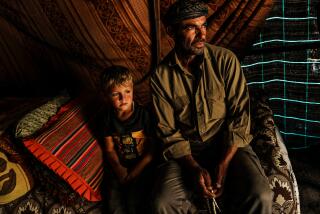Last British detainee at Guantanamo returns home after release
Reporting from London — The last British resident detained at Guantanamo Bay returned home Friday after almost 14 years in which he became a defiant spokesman for the prisoners.
Shaker Aamer, a Saudi citizen who married a British woman and moved to London in 1997, landed at Biggin Hill Airport at about 1 p.m. local time aboard a private plane that taxied into an airport hangar. Aamer, who was never charged with a crime, was released from the U.S. military prison in Cuba on Thursday evening.
The release of Aamer comes after a publicity campaign and at the request of Prime Minister David Cameron, who had urged President Obama to resolve the case of the last prisoner at Guantanamo with significant ties to Britain.
NEWSLETTER: Get the day’s top headlines from Times Editor Davan Maharaj >>
“He needs, first, to be in a hospital, and then to be with his family,” said Clive Stafford Smith, one of Aamer’s lawyers.
His release, the 15th from Guantanamo this year, brings the detainee population there to 112, and comes as part of a renewed push by Obama to close the facility opened by his predecessor after the Sept. 11, 2001, attacks on the U.S.
Aamer, 48, had told his lawyers that he would seek a medical examination in Britain because of concerns about his health stemming in part from repeated hunger strikes while at Guantanamo.
He has received more media attention over the years than any other prisoner except the five who face trial by military commission for their alleged roles planning and providing support to the 9/11 attacks on the World Trade Center in New York.
Aamer was born in Saudi Arabia and remains a Saudi citizen, but wanted to return to London, where he has four children, including a son he has never seen. His wife is the daughter of a prominent retired imam.
He has said he went to Afghanistan to help run a school for girls, and fled during the chaos following the U.S. invasion. He was captured by the Northern Alliance and turned over to the United States for a bounty. He was taken to Guantanamo in February 2002.
The U.S. Defense Department has disclosed that he was accused of significant links to terrorism. They said he shared an apartment in the late 1990s with Zacarias Moussaoui, who was convicted of taking part in the 9/11 conspiracy; had met with Richard Reid, who tried to blow up a U.S. passenger jet with explosives in his shoes; had undergone Al Qaeda training in the use of explosives and missiles; and received a stipend from 9/11 mastermind Osama bin Laden.
Those allegations and more were later found in a November 2007 detainee assessment obtained and published by WikiLeaks that described him as a member of Al Qaeda and a “close associate” of Bin Laden.
The United States never charged him with a crime, and Aamer and his supporters have denied the allegations. Smith notes that Aamer had been cleared for release by the administration of President George W. Bush in June 2007.
Human rights advocates wondered why -- despite a so-called special relationship with the United States -- Britain was unable to secure his release earlier.
“Shaker Aamer’s release will bring huge relief to his family but serious questions remain,” said Shami Chakrabarti, director of the human rights advocacy group Liberty. “Why did it take us so many years to persuade our closest ally to behave decently?”
Aamer spent much of his time at Guantanamo in the disciplinary units of Camp 5, a section of the detention center where prisoners are held alone in solid-walled cells of steel and concrete.
He helped organize a hunger strike that involved more than 100 prisoners and often served as an unofficial spokesman, providing detailed insider accounts of life inside Guantanamo through his lawyers.
Aamer was one of several men picked to serve on a short-lived prisoner council formed in the summer of 2005 in an attempt to address detainee complaints. His supporters long maintained that the reason he was not released was because of his activism and fears that upon his release he would publicly air information about the mistreatment he and others endured at the hands of their captors.
Aamer’s biggest challenge will be reintegrating into society after a long absence, said Moazzam Begg, a former Guantanamo Bay inmate.
“In Shaker’s case, I can’t even begin to imagine. The last time he saw his daughter, for example ... she was 4 years old. She’s now 17. I don’t know how that’s going to happen, how that process is going to happen,” Begg told Sky News last month. “No amount of therapy and so forth will be able to replace those years, so I think this will be a harder struggle for Shaker to deal with than the actual imprisonment.”
ALSO
Polish court rejects U.S. request to extradite Roman Polanski
Austria to build fence along parts of border with Slovenia to ‘bring order’ to migrant flow
China’s Studio City, a Hollywood-themed casino-resort, opens in Macau
More to Read
Sign up for Essential California
The most important California stories and recommendations in your inbox every morning.
You may occasionally receive promotional content from the Los Angeles Times.










